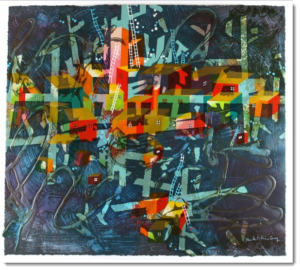What is Impressionism?

“City in Blue” Limited Edition Serigraph Print by Yankel Ginzburg
Impressionism is perhaps the most important movement in the whole of modern painting. At some point in the 1860s, a group of young artists decided to paint, very simply, what they saw, thought, and felt. They did not seek perfection in visual appearances or try to capture exactness in their subject matter, as painters had done in the past. Instead, as their name suggests, the Impressionists tried to get down on canvas an “impression” of how a landscape, thing, or person appeared to them at a certain moment in time.
History of Impressionism
Impressionism often meant using much lighter and looser brushwork than painters had up until that point, and often painting outdoors. The Impressionists also rejected official exhibitions and painting competitions set up by the French government, instead organizing their own group exhibitions, to which the public was initially very hostile. Impressionism was the forerunner of all ‘modern art’ and the whole associated philosophy of the avant-garde.
The word “impressionism” was first derived from one of Claude Monet’s work which he entitled “Impression, soleil levant” or “Impression, Sunrise.”
Tenets of Impressionism
- The Impressionists used looser brushwork and lighter colors than previous artists. They abandoned traditional three-dimensional perspective and rejected the clarity of form that had previously served to distinguish the more important elements of a picture from the lesser ones. For this reason, many critics faulted Impressionist paintings for their unfinished appearance and seemingly amateurish quality.
- Picking up on the ideas of Gustave Courbet, the Impressionists aimed to be painters of the real; they aimed to extend the possible subjects for paintings. Getting away from depictions of idealized forms and perfect symmetry, they concentrated on the world as they saw it, which was imperfect in many ways.
- Scientific thought in the Impressionist era was beginning to recognize that what the eye perceived and what the brain understood were two different things. The Impressionists sought to capture the former – the optical effects of light – to convey the fleeting nature of the present moment, including ambient features such as changes in weather, on their canvases. Their art did not necessarily rely on realistic depictions.
- Impressionism records the effects of the massive mid-19th-century renovation of Paris, which included the city’s newly constructed railway stations; wide, tree-lined boulevards that replaced the formerly narrow, crowded streets; and large, deluxe apartment buildings. The works that focused on scenes of public leisure – especially scenes of cafés and cabarets – often conveyed the new sense of alienation experienced by the inhabitants of the first modern metropolis.
Contact Zimmerman Fine Art Today!
Since 1979 Zimmerman Editions Ltd. has worked closely with many internationally acclaimed artists to execute editions of their most unique images. Collaborating directly with the artists, Zimmerman Editions’ atelier has printed, fabricated, and published many special limited editions of fine art, including both prints and sculptures. All images have been faithfully produced to meet the artists’ most exacting requirements. Many of these high-quality art prints and objets d’art are represented in public and private collections around the world.
If you are a fine art dealer or marketer, or interested in collecting contemporary fine art, contact us today through our short form or our number at 888-484-1850. For more about fine art, keep in touch through Facebook, Twitter, and LinkedIn!
